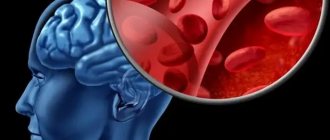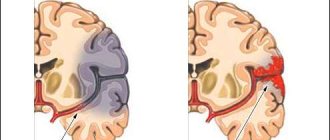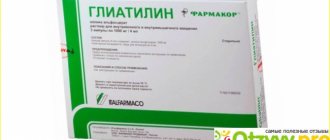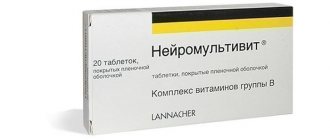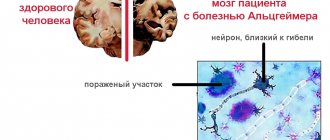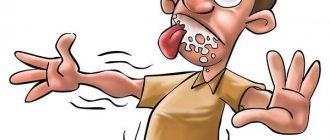Neuroprotectors – types, purpose, mechanisms of action
The category of neuroprotectors includes substances that prevent damage to neurons in the brain and nervous system as a result of exposure to negative factors.
Neuroprotective drugs protect, adapt and improve the activity of neurons, stimulate mental activity, and increase cognitive functions. It is impossible to call “better neuroprotectants”, because this is an extensive list of substances with different structures and mechanisms of action. The list of neuroprotectors is conventionally divided into several groups:
Neuroprotectors: list of drugs, action and review of effectiveness – Chest pain
Soldatenkov Ilya Vitalievich, general practitioner
Neuroprotectors are a group of pharmaceuticals that protect cells of the nervous system from the effects of negative factors. They help brain structures quickly adapt to pathological changes that occur in the body during stroke, TBI, and neurological diseases.
Neuroprotection allows you to preserve the structure and function of neurons. Under the influence of neuroprotective drugs, metabolism in the brain is normalized and the energy supply to nerve cells is improved. Neurologists have been actively prescribing these drugs to patients since the end of the last century.
Neuroprotectors are cytoprotective drugs, the action of which is ensured by the correction of membrane stabilizing, metabolic and mediator balance. Any substance that protects neurons from death has a neuroprotective effect.
Based on the mechanism of action, the following groups of neuroprotectors are distinguished:
- Nootropics,
- Antioxidants,
- Vascular drugs,
- Combined action medications,
- Adaptogenic agents.
Neuroprotectors or cerebroprotectors are medications that stop or limit damage to brain tissue caused by acute hypoxia and ischemia.
As a result of the ischemic process, cells die, hypoxic, metabolic and microcirculatory changes occur in all organs and tissues, up to the development of multiple organ failure.
To prevent damage to neurons during ischemia, neuroprotectors are used. They improve metabolism, reduce oxidation processes, increase antioxidant protection, and improve hemodynamics.
Neuroprotectors help prevent damage to nervous tissue during frequent climate changes, after neuro-emotional stress and overexertion. Thanks to this, they are used not only for therapeutic purposes, but also for preventive purposes.
To treat children, a huge number of neuroprotectors with different mechanisms of action are used in dosages appropriate to age and body weight. These include typical nootropics - Piracetam, vitamins - Neurobion, neuropeptides - Semax, Cerebrolysin.
These drugs increase the resistance of nerve cells to the aggressive effects of traumatic factors, intoxication, and hypoxia. These medications have a psychostimulating and sedative effect, reduce the feeling of weakness and depression, and eliminate the manifestations of asthenic syndrome.
Neuroprotectors affect higher nervous activity, perception of information, and activate intellectual functions. The mnemotropic effect is to improve memory and learning, while the adaptogenic effect is to increase the body’s ability to withstand harmful environmental influences.
Under the influence of neurotropic drugs, blood supply to the brain improves, headaches and dizziness decrease, and other autonomic disorders disappear. Patients experience clarity of consciousness and an increased level of wakefulness. These drugs do not cause addiction or psychomotor agitation.
Nootropic drugs
Nootropics are drugs that stimulate metabolism in nervous tissue and eliminate neuropsychic disorders. They rejuvenate the body, prolong life, activate the learning process and speed up memorization. The term “nootropic” literally means “change the mind” when translated from ancient Greek.
- Piracetam is the most famous representative of nootropic drugs, widely used in modern traditional medicine for the treatment of psychoneurological diseases. It increases the concentration of ATP in the brain, stimulates the synthesis of RNA and lipids in cells. Piracetam is prescribed to patients during the rehabilitation period after acute cerebral ischemia. The drug is the first nootropic that was synthesized in Belgium in the last century. Scientists have found that this medicine significantly increases mental performance and perception of information.
- Cerebrolysin is a hydrolysate obtained from the brain of young pigs. It is a partially degraded whey protein enriched with amino peptides. Due to its low molecular weight, Cerebrolysin quickly penetrates the blood-brain barrier, reaches brain cells and exerts its therapeutic effect. This medicine is of natural origin, due to which it has no contraindications and rarely causes side effects.
- "Semax" is a synthetic neuropeptide complex that has a pronounced nootropic effect. It is an analogue of a fragment of adrenocorticotropic hormone, but does not have hormonal activity and does not affect the functioning of the adrenal glands. "Semax" adapts brain function and promotes the formation of resistance to stress damage, hypoxia and ischemia. This medicine is also an antioxidant, antihypoxant and angioprotector.
- "Cerakson" is prescribed to patients who have had a stroke. It restores damaged membranes of nerve cells and prevents their further death. For patients with TBI, the drug allows them to quickly recover from post-traumatic coma, reduces the intensity of neurological symptoms and the duration of the rehabilitation period. In patients, after active therapy with the drug, clinical signs such as lack of initiative, memory impairment, difficulties in the process of self-care disappear, and the general level of consciousness increases.
- “Picamilon” is a drug that improves cerebral circulation and activates metabolism in brain tissue. The medicine has the properties of an antihypoxant, antioxidant, antiplatelet agent and tranquilizer at the same time. In this case, depression of the central nervous system does not occur, drowsiness and lethargy do not occur. "Picamilon" eliminates symptoms of fatigue and psycho-emotional overload.
Vascular drugs
Classification of the most used vascular drugs: anticoagulants, antiplatelet agents, vasodilators, calcium channel blockers.
- Anticoagulants: Heparin, Sincumarin, Warfarin, Phenilin. These drugs are anticoagulants that disrupt the biosynthesis of blood clotting factors and inhibit their properties.
- Acetylsalicylic acid has an antiplatelet It inactivates the enzyme cyclooxygenase and reduces platelet aggregation. In addition, this drug has indirect anticoagulant properties, realized by inhibiting blood clotting factors. "Acetylsalicylic acid" is prescribed for prophylactic purposes to persons with cerebrovascular accidents who have suffered a stroke or myocardial infarction. "Plavix" and "Tiklid" are analogues of "Aspirin". They are prescribed in cases where their “Acetylsalicylic acid” is ineffective or contraindicated.
- “Cinnarizine” improves blood fluidity, increases the resistance of muscle fibers to hypoxia, and increases the plasticity of erythrocytes. Under its influence, brain vessels dilate, cerebral blood flow improves, and the bioelectrical ability of nerve cells is activated. "Cinnarizine" has an antispasmodic and antihistamine effect, reduces the reaction to certain vasoconstrictors, reduces the excitability of the vestibular apparatus, without affecting blood pressure and heart rate. It relieves spasms of blood vessels and reduces cerebroasthenic manifestations: tinnitus and severe headaches. The medication is prescribed to patients with ischemic stroke, encephalopathy, Meniere's disease, dementia, amnesia and other pathologies accompanied by dizziness and headache.
- Vinpocetine is a semi-synthetic vasodilator that eliminates hypoxia and increases the resistance of neurons to oxygen deficiency. It reduces platelet aggregation and increases cerebral blood flow, mainly in ischemic areas of the brain. Vinpocetine and Cinnarizine are indirectly acting antihypoxants. Their therapeutic effect is due to the transfer of the body to a lower level of functioning, allowing it to perform full-fledged physical and mental work. The antihypoxic effect of these drugs is considered indirect.
- "Trental" dilates blood vessels, improves microcirculation and cerebral blood flow, provides brain cells with the necessary nutrition, and activates metabolic processes. It is effective for osteochondrosis of the cervical spine and other diseases accompanied by a significant deterioration in local blood flow. The main active ingredient of the drug causes relaxation of the smooth muscle walls of blood vessels, increases their diameter, improves the elasticity of the walls of red blood cells, due to which they calmly pass through the vessels of the microvasculature. The drug dilates mainly the blood vessels of the heart and brain structures.
Drugs with combined effects
Neuroprotective drugs of combined action have metabolic and vasoactive properties that provide the fastest and best therapeutic effect when treated with low doses of active substances.
- "Tiocetam" has a mutually potentiating effect of "Piracetam" and "Tiotriazolin". Along with cerebroprotective and nootropic properties, the drug has antihypoxic, cardioprotective, hepatoprotective, and immunomodulatory effects. Thiocetam is prescribed to patients suffering from diseases of the brain, heart and blood vessels, liver, and viral infections.
- Phezam is a drug that dilates blood vessels, improves the body's absorption of oxygen, and helps increase its resistance to oxygen deficiency. The medicine contains two components: Piracetam and Cinnarizine. They are neuroprotective agents and increase the resistance of nerve cells to hypoxia. Phezam accelerates protein metabolism and glucose utilization by cells, improves interneuronal transmission in the central nervous system and stimulates blood supply to ischemic areas of the brain. Asthenic, intoxication and psychoorganic syndromes, disorders of thinking, memory and mood are indications for the use of Phezam.
Neuroprotectors – stimulants
These are neuroprotective drugs that stimulate the activity of the central nervous system. The most well-known stimulant of the central nervous system is caffeine. It also stimulates the cardiovascular system, constricts blood vessels and has a mild diuretic effect. Caffeine has a beneficial effect on the respiratory system and increases intellectual and physical functionality. This is the most popular neuroprotector for eliminating drowsiness.
Cerebrovascular
Vascular agents form the basis for the systemic correction of many processes: from hypertension to chronic encephalopathies, disorders of normal nutrition of cerebral structures.
They are universal compared to nootropics, but they give much more side effects. The group is heterogeneous and includes a number of subtypes, which are combined based on the mechanisms of beneficial effects on the patient’s body.
- Restoring blood flow. By reducing the rate of synthesis of certain specific substances, those that disrupt the tone of large arteries. There are also other routes of direct exposure; the biochemical characteristics depend on the specific name and subgroup.
- Normalization of rheological properties of blood. Liquefaction, increased fluidity. Which becomes a factor in eliminating eating disorders. Although not always.
- Correction of the condition of vascular walls. Reducing the rate of oxidation, restoring elasticity. This preventive effect of neuroprotective agents helps prevent many problems: including reducing the likelihood of hemorrhagic stroke or cerebral aneurysms in the future.
Indirectly, cerebrovascular medications improve mental activity, memory, attention and relieve symptoms of neurological deficits: from headaches to others.
If we talk about specific names of such cerebroprotectors:
They disrupt the process of platelet aggregation. Essentially, this effect provides an increase in blood fluidity. Many medications of this kind have a mild effect, therefore they create a minimum of danger with a high therapeutic ability.
Classic names include products based on acetylsalicylic acid: Aspirin, Thrombo ass. More modern types that do not have this substance in the structure and composition: Clopidogrel, Ticlopidine and others. Use strictly according to indications.
The group of antiplatelet agents is described in detail in this article.
A much more powerful pharmacological group. Capable of disrupting the synthesis of coagulation factors. These medications have many more side effects. Use is only possible in a limited number of cases. Anticoagulant drugs with heparins of different weights are presented.
Read a detailed review of anticoagulant agents here.
The combined drug allows you to solve a group of problems at once: normalize blood fluidity due to minimal antiplatelet activity, relieve spasms of the brain arteries, restore blood pressure, intellectual abilities, and thinking capabilities.
The medicine has relatively few side effects, but if used incorrectly, it provokes obvious asthenic phenomena - fatigue, decreased performance. This must be taken into account when prescribing treatment.
Available in the form of tablets and ampoules for injection. Has a specific effect. Functions as a vasodilator. That is, it dilates blood vessels, helps improve the nutrition of brain tissue (a group of vasodilator drugs is described in detail here).
On the other hand, the medication helps reduce the oxygen demand of neurons and helps optimize the functioning of cerebral structures. It is used in a wide range of cases.
Neuroprotective therapy includes not only nootropics or cerebrovascular ones; as a rule, several types of different types are used to solve specific treatment problems. Of which there are usually many, especially in patients with ischemic disorders.
Neuroprotectors – antioxidants
Many antioxidants act as neuroprotectors, as they inhibit the reactions of non-enzymatic free radical oxidation of proteins, fats and other substances, providing a membrane-protective effect. These substances help preserve the functional properties of neurons.
An example is the neuroprotector glycine, which has an “inhibitory” effect on “exciting” amino acids like glutamic acid and at the same time stimulates the synthesis of GABA, the most important neurotransmitter of the brain, normalizing the sleep-wake cycle, improving cognitive functions and eliminating mental arousal.
Classification of plant neuroprotectors (Reviews)
Key words: neuroprotectors, medicinal plants, complex therapeutic effect
Neuroprotectors are classified as mixed-type nootropic drugs with a wide range of effects. The therapeutic effect of nootropic drugs is based on several mechanisms: improvement of the energy state of neurons (increased ATP synthesis, antihypoxic and antioxidant effects); activation of plastic processes in the central nervous system due to increased RNA synthesis; strengthening of synaptic transmission processes in the central nervous system; improved glucose utilization; membrane-stabilizing effect [4].
Neuroprotection involves mainly antioxidant, anti-excitotoxic (preventing cell death), blocking calcium ions and neurotrophic effects.
Substances with neuroprotective effects are mainly:
- antioxidants (enzyme and non-enzyme ROS inactivation systems),
- calcium channel blockers (calcium antagonists, Ca2+),
- substances affecting the GABA system (GABA receptor modulators),
- brain metabolism activators,
- cerebral vasodilators,
- substances of various groups.
Under physiological conditions, the formation of reactive oxygen species (ROS) and free radical oxidation (FRO) is necessary for normal cell functioning; in particular, free radical nitric oxide (NO) is an essential mediator of vasorelaxation, and its deficiency leads to hypertension. Some ROS serve as mediators in cellular signaling pathways. SRO determines the structural features of the phospholipid layer of biological membranes, membrane receptors, energy and plastic supply of cells, synthesis of prostaglandins, nucleic acids, lipolysis, transport of metabolites, excitability of CNS cells, correction of other metabolic processes.
However, if the concentrations of ROS - superoxide anion (O-2), hydrogen peroxide (H2O2), hydroxyl ion (OH-), singlet (atomic) oxygen (O2) - reach critical values, then pathological processes develop under conditions of excessive intensification of FRO. According to modern concepts, FRO is one of the universal mechanisms of cell damage and a universal pathological factor in many diseases [10]. In clinical medicine, free radical pathology with all its features is called oxidative or oxidative stress.
During oxidative (oxygen) stress, free radical metabolites (FRM) and oxygen-containing radical metabolites (OCRM), such as peroxide and nitroxide radicals, as well as lipid peroxidation (LPO) products accumulate. Oxidative damage to biological molecules is generated mainly by free radicals. Neurodegenerative diseases, a number of inflammatory diseases, atherosclerosis, cataracts, cardiovascular diseases, cancer, and the aging process are increasingly associated with the consequences of SRO [16,85]. Severe forms of oxidative stress are an important pathogenetic factor leading to severe consequences (myocardial infarction, ischemic stroke, diabetes mellitus, hypertension, etc.), a complex of which clinicians refer to as metabolic syndrome [10].
To prevent oxidative damage to biological molecules by free radicals, natural antioxidant systems with different principles of action can be used - ascorbic acid, tocopherols, carotenoids, substances of polyphenolic nature (flavonoids, proanthocyanidins, tannins, substances containing phenolic hydroxyl groups), polyenes (compounds with several unsaturated bonds) [1, 2, 3, 8, 81].
The possibility of using natural modulators is currently being studied in many laboratories. Moreover, the range of substances is very wide – from human hormones to medicinal plant extracts.
Understanding the molecular mechanisms of neuroprotection, oxidative stress and immune function helps to simplify the possible prevention of neurodegenerative diseases by diet, food products with the addition of medicinal plants and plant extracts [15]. The dietary factor is a modulator of physiological functions (including brain function), as a result, an increase in the economic productivity of the population is derived from the health of the population.
Table
conclusions
- Neuroprotectors of plant origin belong to various groups of chemical compounds:
- alkaloids,
flavonoids (catechins, proanthocyanidins, flavones, flavonols, biflavonoids),
- tannins,
- phenolic acids and their derivatives,
- terpenoids (aliphatic monoterpenoids, monocyclic, bicyclic, quinones),
- diterpenoids (quinones, lactones, acids, alcohols),
- triterpenoids,
- polyacetylene alcohols,
- neurotransmitter amino acids,
- L-theanine,
- xanthine derivatives,
- vitamins (tocopherols, ascorbic acid).
- The variety of compounds is due to the fact that neuroprotectors are nootropic compounds with a wide range of effects.
- The primary direction of protective therapy of neuroprotectors includes interrupting the rapid mechanisms of necrotic cell death - reactions of the glutamate-calcium cascade (blockade of calcium channels). These include vincamine, 6-methylapigenin, taxifolin, patuletin, axillarin, resveratrol (activator of sirtuins, the SIRT1 protein responsible for chromosome integrity); GABA.
- The secondary direction of protective therapy of neuroprotectors includes interruption of delayed mechanisms of cell death - oxidative stress, accumulation of ROS in mitochondria, imbalance of cytokines (mediators of neuroinflammatory processes), local inflammation, apoptosis, impaired neurotrophic function, etc. These include catechins, oligomeric proanthocyanidins, flavones, flavonols, isoflavones, biflavonoids, sesquiterpenoids and others.
Literature
- Astakhov Yu.S., Skorobogatov Yu.V. New possibilities of neuroprotection in the complex treatment of glaucoma with herbal preparations (according to literature data). Russian Medical Journal, 2007, 7, p. 130-137.
- Vanyushin B.F. Apoptosis in plants. Advances in biological chemistry, M., 2001, v. 41, p. 3-38.
- Velikaya N.V., Zalessky V.N. On the issue of preventing the development of neuronal apoptosis by flavonoids-phenol-containing compounds of plant products. National A.A. Bogomolets Medical University, Kyiv, 2004.
- Voronina T.A., Seredenin S.B.. Nootropic drugs, achievements and new problems. Experimental and clinical pharmacology, 1998, v. 61, 4, p. 3-9.
- Kuznetsov V.V., Shevyakov N.I. Proline under stress: biological role, metabolism, regulation. Plant Physiology, 1999, v. 46.2, p. 321-336.
- Kulinsky V.I. Neurotransmitters and the brain. Soros Educational Journal. M., 2001, vol. 7, 6 (67), pp. 11-16.
- Kushnerova N.F., Sprygin V.G., Rakhmanin Yu.F. Regulation of the metabolism of ethyl alcohol in the body by oligomeric proanthocyanidins as a way to prevent its toxic effects. Hygiene and sanitation. 2003, 5, pp.58-61.
- Mnatsakanyan V.A., Eribekyan M.I., Ananikyan V.V. Comparative assessment of the antiradical activity of some isoquinoline alkaloids. Globe of Science, 2009, 8, p. 31-33.
- Prozorovsky V.B. Inhibitory amino acids. Exciting amino acids. Protect the brain from overload and aging. Chemistry and Life, 2006, 7, pp. 46-49.
- Seifulla R.D., Rozhkova E.A., Kim E.K. Antioxidants. Experimental and clinical pharmacology, 2009, 72, 3, pp. 60-64.
- Sprygin V.G., Kushnerova N.F., Fomenko S.E. Antiradical activity of extracts from Far Eastern plants containing an oligomeric proanthocyanidin complex. Bull. Physiology and pathology of breathing, 2002, 11, p. 50-53.
- Sprygin V.G., N.F. Kushnerova. Natural oligomeric proanthocyanidins are promising regulators of metabolic disorders. Bulletin of the Far Eastern Branch of the Russian Academy of Sciences, 2006, 2, p. 81-90.
- Khavkin E.G. Age-related changes in free amino acids and accumulation of -aminobutyric acid in the leaves of legumes. Plant Physiology, 1964, 11.5, p. 862-866.
- Amiot-Carlin M.-J., Tourninaire F., Margotat. A. Flavonoids in Food and Wine. ISHS Acta Horticulturae 744: International Symposium of Human Health Effects of Fruits and Vegetables, 2008.
- Aruoma Ol., Bahorun T., Jen LS Neuroprotection by bioactive components in medicinal and food plant extracts. Mutation Research The Fourth International Conference on Environmental Mutagens in Human Populations, 2003, vol. 544(2-3); 203-215.
- Bandyopadhyay D., Chattoypadhyay A., Ghosh G., Datta AG Oxidative stress-induced ischemic heart disease: protection by antioxidants. Curr.Med.Chem., 2004, vol.11. 3, p. 369-387.
- Bastianetto S., Zheng WH, Quirion R. Neuroprotective abilities of resveratrol and other red wine constituents against nitric oxide related toxicity in cultured hippocampal neurons. British Journal of Pharmacolology. 2000, 131, 711-720.
- Baur R., Simmen U., Seen M., Seguin U., Sigel E. Novel plant substances acting as beta subunit isoform-selective positive allosteric modulators of GABAA receptors. Molecular Pharmacology, 2005, 68, p.787-792.
- Baureithel KH, Zheng WH, Engesser A., Burkard W., Schaffer W. Inhibition of benzadepine binding in vitro by amentaflavone, a constituent of various species of Hypericum. Pharm. Acta Helv., 1997, 72, p.153-157.
- Bors W., Michel C., Stettmaier K. Electron paramagnetic resonance studies of radical species of proanthocyanidins and gallate esters. Archives of Biochemistry and Biophysics, 2000, 374, 2, p. 347-355.
- Borzellega J., Peters D., Hall W. A 13-week dietary toxicity and toxicokinetic study with L-theanine in rats. Food Chemical Toxicology, 2006, 44(7): 1158-1166.
- Bouche N., Lacombe B., Fromm H. GABA signaling: A conserved and ubiquitous mechanism. Trends in Cell Biology, 2003, 13, 607-610.
- Bouche N., Fromm H. GABA in plants: Just a metabolite? Trends in Plant Science, 2004, 9, p. 110-115.
- Bown AW, Shelp BJ The metabolism and function of gamma-aminobutyric acid. Plant Physiology, 1997, 115: p. 1-5.
- Brochet D., Chermat R., DeFeudis FV, Drieu K. Effects of single intraperitoneal injections of an extract of Ginkgo biloba (EGb 761) and its terpene trilactone constituents on barbital-induced narcosis in the mouse. General Pharmacology, 1999, 33, p.249-256.
- Brosnan JT, Brosnan ME. The Sulfur-Containing Amino Acids. The American society for nutrition J. Nutr., 2006, 136: 1636S-1640S.
- Campbell EL, Chebib M., Johnston GAR The dietary flavonoids apigenin and (-) epigallocatechin gallate enhance the positive modulation by diazepam of the activation by GABA of recombinant GABAA receptors. Biochemical Pharmacology, 2004, 68, p. 1631-1638.
- Casimir J., Renard M. Separation and characterization of N-ethyl-gamma-glutamine from Xerocomus badius. Biochim.Biophys. Acta, 1960, 39: 462-468.
- Choi SE, Choi S., Lee JH, Whiting PJ, Lee SM, Na SY Effects of ginsenolides on GABAA receptor channels expressed in Xenopus oocytes. Arch. Pharm. Res., 2003, 26, p.28-33.
- Choi YB, Kim YI, Lee KS, Kim BA, Kim DJ Protective effect of epigallocatechin gallate on brain damage after transient middle cerebral artery occlusion in rats. Brain Res., 2004, 1019, p.47-54.
- Chun Su Yuan, Sangeeta Mehendale, Yingping Xiao, Han H. Aung, Jing-Tian Xie, Michael K. Ang-Lee. The Gamma-Aminobutyric Acidergic Effects of Valerian and Valerenic Acid on Rat Brainstem Neuronal Activity. International Anesthesia Research Society, 2004, p.353-358.
- Condit EM, Keller B. The glycine-rich cell wall proteins of higher plants. Organization and assembly of plant and animal extracellular matrix. San Diego: Academic Press, 1990, p.119-135.
- Cossins E., Lee R., Parker L. ESR studies of vitamin C regeneration, order of reactivity of natural source phythochemical preparations. Biochemistry and Molecular Biology, 1998, vol. 45. 3. p.583-597.
- Dajas F., Rivera-Megret F., Blasina F., Arredondo F., Abin-Carriquiry JA, Costa G., Echeverry C., Lafon L., Heisen H., Ferrejra M., Morquio A. Neuroprotection by flavonoids. Brazilian Journal of Medical and Biological Research, 2003, 36, 12, p.1613-1620.
- DeFeudis FV Bilobalide and neuroprotection. Pharmacological Research, 2002, 46, p.565-568.
- Deiml T., Haseneder R., Zieglgansberger W., Rammes G., Eisesamer B., Rupprecht R., Hapfelmeier G. Alpha-tujone reduced 5-HT3 receptor activuty and effect on the agonist-induced desensitization. Neuropharmacology, 2004, vol. 46, p.192-201.
- Delauney AJ, Verma DPS Proline biosynthesis and osmoregulation in plants. The Plant Journal, 1993, 4, p.215-223.
- Dietz BM, Mahady GB, Pauli GF, Farnsworth NR Valerian extract and valerianic acid are partial agonist of the 5-HT5a receptor in vitro. Brain research. Molecular brain research, 2005, 138, p.191-197.
- Egashira N., Ishigami N., Pu F. et al. Theanine prevents memory impairment induced by repeated cerebral ischemia in rats. Phytotherapy Research, 2008, vol. 22 (1): 65-68.
- Fernandez S., Wasowski C., Paladini AC, Marder M. Sedative and sleepenhancing properties of linarin, a flavonoid isolated from Valeriana officinalis. Pharmacology, biochemistry, and behavior, 2004, 77, p.399-404.
- Fine AM Oligomeric proanthocyanidin complexes: history, structure and phytophar-maceutical applications. Altern. Med. Rev., 2000, vol. 5, p.553-562.
- Fuhrman B., Aviram M. Pomegranate and cardiovascular diseases: Pomegranate Juice Polyphenolic Antioxidants Protect against Oxidative Stress and Atherosclerosis Development. ISHS Acta Horticulturae 744:International Symposium of Human Health Effects of Fruits and Vegetables, Canada, 2008.
- Gehm BD, McAndrews JM, Chien PY, Jameson JL Resveratrol, a polyphenolic compound found in grapes and wine, is an agonist for the estrogen receptor. Proceedings of the National Academy of Sciences of the United States of America, 1997; 94(25):14138-43.
- Ghochikyan AT, Topchyan HV, Margaryan TS, Revazova LV Gamma-aminobutyric acid (GABA) in some medicinal and food plants. The Second International Symposium BIOPHARMA-2010: From Science to Industry, proceedings, 2010, p. 14-15.
- Gomez-Ramirez M, Higgins BA, Rycroft JA, Owen GN, Mahoney J., Shpaner M., Foxe JJ The Deployment of Intersensory Selective Attention: A High-density Electrical Mapping Study of the Effects of Theanine. Clinical Neuropharmacology, 2007, 30(1): 25-38.
- Gottesmann C. GABA mechanisms and sleep. Neuroscience, 2002, vol. 111, p.231-239.
- Grander RE, Campbell EL, Jonson GAR (+)-and (-)-borneol: Efficacious positive modulators of GABA action at human recombinant alfa-1, beta2-gamma2L GABAA receptors. Biochemical Pharmacology, 2005, 69, p.1101-1111.
- Hanrahan JR, Cherib M., Davucheron NM, Hall BJ, Jonston GAR Semisynthetic preparation of amenthoflavone: A negative modulator at GABAA receptors. Bioorganic and Medicinal Chemistry Letters, 2003, vol. 13, 14, p.2281-2284(4).
- Haskell CF, Kennedy DO, Milne AL, Wesnes KA, Scholey AB The effects of L-Theanine, caffeine and their combination on cognition and mood. Biological Psychology, 2008, 77(2): 113-122.
- Hiroyuki K., Ohnishi N. Occurrence of Taurine in Plants. Agric. Biological Chemistry, 1986, 50(7), p.1887-1888.
- Hold KM, Sirisoma NS, Ikeda T., Narahashi T., Casida JE -Tujone (the active component of absinthe): -Aminobutyric acid type A receptor modulation and metabolic detoxication. Proceedings of the National Academy of Sciences, USA, 2000, 97, p.3826-3831.
- Hossain SJ, Aoshima H., Koda H., Kiso Y. Effects of coffee components on the response of GABAA receptors expressed in Xenopus oocytes. Journal of Agricultural and Food Chemistry, 2003, 51, p.7568-7575.
- Hossain SJ, Aoshima H., Koda H., Kiso Y. Fragrances in oolong thea that enhance the response of GABAA receptors. Bioscience, Biotechnology and Biochemistry, 2004, 68, p.1842-1848.
- Hosseinzadeh H., Parvardeh S. Anticonvulsant effects of thymoquinone, the major constituent of Nigella sativa seeds, in mice. Phytomedicine, 2004, 11, p.56-64.
- Huang SH, Duce RK, Ghebib M., Sasaki K., Wada K., Johnston GAR Bilobalide, a sesquiterpene trilactone from Ginkgo biloba, is an antagonist at recombinant alpha(1)beta(2)gamma2L GABAA receptors. European journal of pharmacology, 2003, 464, p.1-8.
- Huang SH, Duce RK, Ghebib M., Sasaki K., Wada K., Johnston GAR Ginkgolides, diterpene dilactones of Ginkgo biloba, as antagonists at recombinant alpha (1) beta (2) gamma2L GABAA receptors. European journal of pharmacology, 2004, 494, p.131-138.
- Huang SH, Duce RK, Ghebib M., Sasaki K., Wada K., Johnston GAR Mixed antagonistic effects of bilobalide at p1 GABAC receptors. Neuroscience, 2006, 137, p.607-617.
- Huen MS, Leung JW, Ng W., Lui WS, Chan MN, Wong JT, Xue H. 5,7-Dihydoxy-6-metoxyflavone, a benzodiazepine site ligand isolated from Scutellaria baicalensis George, with selective antagonistic properties. Biochemical Pharmacology, 2003, 66, p.125-132.
- Jonhston GAR, Cherib M., Hanrahan JN, Mewett KN GABAC receptors as drug targets. Current Drug Targets-CNS & Neurological Disorders., 2003, 2, p.260-268.
- Johnston GAR, Hanrahan JR, Cherib M, Rujee K.Duke, Mewett KH Modulation of Ionotropic GABA Receptors by Natural products of Plant Origin. Advance in Farmacology, 2006, vol. 54, p.285-316.
- Kang Tong Ho, Hye Rim Oh, Sun Moon Jung, JongHoon Ryu, Mee Won Park, Yong Kon Park and Sun Yeou Kim. Enhancement of Neuroprotection of Mulberry Leaves (Morus alba L.) Prepared by the Anaerobic Treatment against Ischemic Damage. Biological & Pharmaceutical Bulletin, 2006, 29(2), p.270-274.
- Kathiresan A., Tung P., Chinnappa CC, Peid DM Gamma-aminobutyric acid stimulates ethylene biosynthesis in sunflower. Plant Physiology, 1997, 115: p.129-1.
- Kawai K., Tsuno NH, Kitajama J., Okai Y., Yazama K., Asakage M., Sasaky M., Watanabe T., Takahashi K., Nagawa H. Epigallocatechin gallate Induced apoptosis of monocytes. The Journal of Allergy and Clinical Immunology, 2005, 115, p.186-191.
- Kavvadias D., Monschein V., Sand P., Riedere P., Schreier P. Constituents of sage (Salvia officinalis L.) with in vitro affinity to human brain benzodiazepine receptor. Planta medica, 2003, 69, p.113-117.
- Kavvadias D., Sand P., Youdium KA, Qaiser MZ, Rice-Evans C., Baur R., Sigel E., Rausch W.-D., Riederer P., Sraier P. The flavone hispidulin, a benzodiazepine receptor ligand with positive allosteric properties, traverses the blood-brain barrier and exhibits anticonvulsant effects. British Journal of Pharmacology, 2004, 142, p.811-820.
- Ke Yao, Li Zhang, Vi Dong Zhang, Pan Pan Ye, Nung Zhu. The flavonoid fisetin, inhibits UV radiation-induced oxidative stress and the activation of NF-kB and MAPK signaling in human lens epithelial cells. Molecular Vision, 2008, 14; p.1865-1871.
- Kim SR et al. Flavonoids of Inula britannica protect cultured cortical cells from necrotic cell death induced by glutamate. Free Radical Biology & Medicine, 2002, vol. 32(7), p.596-604.
- Kimura K., Ozeki M., Juneja L., Ohira H. L-Theanine reduced psychological and physiological stress responses. Biological Psychology, 2007, 74(1): 39-45.
- Koda H., Hossain SJ, Kiso Y., Aoshima H. Aging of wiskey increases the potentiation of GABAA receptor response. Journal of Agricultural and Food Chemistry, 2003, 51, p.5238-5244.
- Lee CM, Wong HM, Chui KY, Choang TF, Hon PM, Chang HM Miltirone, a central benzodiazepine receptor partial agonist from a Chinese medicinal herb Salvia miltiorrhiza. Neuroscience Letters, 1999, 127, p.237-141.
- Levites Y., Amit T., Youdin M., Mandel S. Involvement of protein kinase C activation and cell survival/cell cycle genes in green thea polyphenol (-)-epigallocatechin 3-gallate neuroprotective action. Journal of Biological Chemistry, 2002, 277, p.30574-30580.
- Liu B., Hattori N., Zhang N.J., Wu. B., Jang L., Kitagawa K., Xiong ZM, Irie T., Inagaki C. Anxiolytic agent, dihydrohonokiol-B, recovers amyloid beta-protein induced neurotoxicity in cultured rat hippocampal neurones. Neuroscience Letters, 2005, 384, pp.44-47.
- Lu YC, Chen HH, Ko CH, Lin YR, Chan MH. The mechanism of honokiol-induced and magnolol-induced inhibition on muscle contraction and Ca2+ mobilization in rat uterus. NAUNYN-SCHMIEDEBERG'S ARCHIVES OF PHARMACOLOGY, 2003, 368, p.262-269.
- Lu K., Gray M., Oliver C., Liley D., Harison B., Bartholomeusz C., Phan K., Nathan P. The acute effects of L-Theanine in comparison with alprazolam on anticipatory anxiety in humans. Human Psychopharmacology, 2004, 19(7): 457-465.
- Maber P., Hanneken A. Flavonoids Protect Retinal Ganglion Cells from Oxidative Stress-induced Death. Investigative Ophthalmology & Visual Science, 2005, 46, 12, p.4796-4803.
- Maffei Facino R., Carini M., Aldini G. et al. Sparing effects of procyanidins from Vitis vinifera on vitamin E: in vitro studies. Planta Medica, 1998, vol. 64, 4, p. 343-347.
- Maher P., Akaishi T., Abe K. Flavonoid fisetin promotes ERK-dependent long-term potentiation and enhances memory. Proceedings of the National Academy of Sciences of the United States of America, 2006, vol. 103, 44, p.16568-16573.
- Marder M., Viola H., Wasowski C., Fernandez S., Medina JH, Paladini AC 6-methy-lapigenin and hesperidin: new valeriana flavonoids with activity on the CNS. Pharmacology Biochemistry and Behavior, 2003, 75, p.537-545.
- Matsumoto H., Nacamura H., Tachibanaki S., Kamamura S., Hirayama M. Stimulatory effect of cyanidin-3-glycosides on the regeneration of rodopsin. Journal of Agricultural and Food Chemistry, 2003, 51, p.3560-3563.
- Matsumoto H., Nakamura Y., Iida H., Ito K. Comparative assessment of distribution of black current anthocyanins in rabbit and rat ocular tissues. Exp. Eye Res, 2006, 83, p.348-356.
- Medina JH, Viola H, Wolfman C et al. Neuroactive flavonoids: new ligands for the benzodiazepine receptor. Phytomedicine, 1998, 5, p.235-243.
- Minner DD, Lee SK Evaluatuon of plant growth enhancer (GABA - gamma aminobutyric acid) for Establishment of Agrostis palustris Huds. Herbicide and Growth Regulator Research, 2004.
- Nathan P., Lu K., Gray M., Oliver C. The neuropharmacology of L-Theanine (N-ethyl-L-glutamine): a possible neuroprotective and cognitive enhancing agent. Journal of Herbal Pharmacotherapy, 2006, 6(2): 21-30.
- Natella F., Belilli F., Gentili V. et al. Grape seed proanthocyanidins prevent plasma postpropandial oxidative stress in humans. Journal of Agricultural and Food Chemistry, 2002, 50, p.7720-7725.
- Olinski R., Gaskowski D., Foksinski M., Roszkowski K., Jaruga P. Oxidative DNA damage: assessment of the role in carcinogenesis. Atherosclerosis and acquired immunodeficiency syndrome. Free Radical Biology & Medicine, 2002. vol. 33, 33, p.192-200.
- Perry NS, Howes MJ, Houghton P., Perry EK Why sage may be a wise memory remedy: Effects of salvia on the nervous system. Med. Arom. Plants Industry. Profiles, 2000, 14, p.207-223.
- Perry NS, Anderson RE, Brennan NJ, Douglas MH, Heaney AJ, McGimpsey JA, Smallfield BM Essential oils from Dalmatian sage (Salvia officinalis L.): Variations among individual plant parts, seasons and sites. Journal of Agricultural and Food Chemistry, 1999, 47, p.2048-2054.
- Pierce SK, Warren JW The taurine efflux portal used to regulate cell volume in response to hypoosmotic stress seems to be similar in many cell types: lessons to be learned from molluscan red blood cells. The Society for Integrative and Comparative Biology, 2001, 41(4), p.710-720.
- Priestley CM, Williamson EM, Wafford K., Satterle DW Thymol, a constituent of thyme essential oil, is a positive allosteric modulator of human GABA A receptors and a homo-oligomeric GABAA receptor from Drosodhila melanogaster. British Journal of Pharmacology, 2003, 140, p.1363-1372.
- Reynolds L.E.F., ed. Martinale. The extra Pharmacopoeia, 36th ed., London, The Pharmaceutical Press, 2008.
- Rimbach G., Virgili F., Park YC, Parcer L. Effect of proanthocyanidins from Pinus maritima on glutathione levels in endothelial cells challenged by 3-morpholinosydnonimine or activated macrophages. Redox Rep., 1999, vol.4, 4, p. 171-177.
- Roosens Nancy H., Willem Rudolf, Yan Li, Verbruggen Ingrid, Biesemans Monique, Jacobs Michel. Proline metabolism in the wild-type and in a salt-tolerant mutant of Nicotiana plumbaginifolia studio by 13C-nuclear magnetic resonance imaging. Plant physiology, 1999, vol. 121.p. 1281-1290.
- Rutherford DM, Nielsen MPC, Hansen SK, Witt MR, Bergendorf O., Sterner O. Isolation from Salvia officinalis and identification of two diterpenes which inhibit t-butylbicyclophosphoro[35S] thionate binding to chloride channel of rat cerebrocotical membranes in vitro. Neuroscience Letters, 1992, 135, p.224-226.
- Santos MS, Ferreira F., Cunha AP, Carvalho AP, Ribeiro CF, Macedo T. Synaptosomal GABA release as influenced by valerian root extract – involvement of the GABA carrier. Archives internationales de pharmacodynamie et de thérapie, 1994, 327, p.220-231.
- Sasaky K., Hatta S., Haga M., Ohshika H. Effects of bilobalide on gamma-aminobutyric acid levels and glutamic acid decarboxylase in mouse brain. European Journal of Pharmacology, 1999, 367, p.165-173.
- Sasaky K., Oota I., Wada K., Inomata K., OhshiKa H., Haga M. Effects of bilobalide a sesquiterpene in Ginkgo biloba leaves, on population spices in rat hippocampal slices. In Comparative Biochemistry and Physiology Part. C: Pharmacology, Toxicology and Endocrinology, 1999, 124, p.315-321.
- Scalbert A., Deprez S., Mila I. et al. Proanthocyanidins et human health: systemic effects and local effects in the gut. BioFactors (Oxford, England), 2000, vol.13, 1-4, p.115-120.
- Serraj R., Shelp BJ, Sinclair TR Accumulation of -aminobutyric acid in nodulated soybean in response to drought stress. Physiologia Plantarum, 1998, 102, 1, p.79-86.
- Shelp BJ, Bown AW, McLean MD Metabolism and functions of gamma-aminobutyric acid. Trend in Plant Science. 1999, vol. 4, 11, p. 446-452.
- Subramanian Divakaran. Taurine: an Amino Acid Rich in Fish Meal. VIII Symposium International de Nutricion Acuicola. 15-17 November 2006. Monterrey, Nuevo Leon, Mexico.
- Tavakoli AM, Pourshanazari A., Heshmatian B. Vitamin E Derivate Alfa-Tokotrienol Failed to Show Neuroprotective Effects after Embolic Stroke in Rats. Iranian Journal of Basic Medical Science, 2009, 12,1, p.9-17.
- Tildesley NT, Kennedy DO, Perry EK, Ballard CG, Savelev S., Wesnes KA, Scholey A.B., Salvia lavandulaefolia (Spanissh sage) enhances memory in healthy young volunteers. Pharmacology, Biochemistry and Behavior, 2003, 75, p.669-674.
- Turner RT, Evans GL, Zhang MZ, Maran A., Sibonga J. Is resveratrol an estrogen against in growing rats? Endocrinology, 1999, 140, p.50-54.
- Uwai K., Ohashi K., Takaya Y., Ohta T., Tadano T., Kisaro K., Shibusawa K., Sakakibara R., Oshima Y. Exploring the structural basis of neurotoxicity in C(17)-polyacetylenes isolated from water hemlok. Journal of Medicinal Chemistry, 2000, 43, p.4508-4515.
- Uwai K., Ohashi K., Takaya Y., Oshima Y., Furukawa K., Yamagata K., Omura T., Okuyama S. Virol A, a toxic trans-polyacetilenic alcohol of Cicuta virosa, selective inhibits the GABA-induced Cl¯ current in acutely dissociated rat hipocampal A 1 neurons. Brain Research (Elsevier Science Publishing Company), 2001, 889, p.174-180.
- Vandewalle I., Olsson R. The gamma-aminobutyric acid shunt in germinating Sinapis alba seeds. Plant Science Letters, 1983, 31, p.269-273.
- Vidal, 2000. Vidal Reference. Medicines in Russia, ed. VI, AstraPharmService, E-358.
- Viola H., Wasowski C., Levi de Stein M., Wolfman C., Silvera R., Medina AE, Paladini AC, Apigenin, a component of Matricaria recutita flowers, is a central bensodiasepine receptor-ligand with anxiolitic effects. Planta medica, 1995, 61, p.213-216.
- Vladimirov YA, Proscurnina EV, Demin EM, Matveeva NS, Lubitskij OB, Novikov AA, Izmailov DY, Osipov AN, Tikhonov VP, Kagan VE Dihydroquercetin (taxifolin) and other flavonoids as inhibitors of free radical formation at key stages of apoptosis. Biochemistry (Moscow), 2009, 74(3), p. 301-307.
- Wang HY, Hui KM, Chen YJ, Xu SX, Wong JTF, Xue H. Structure-activity relationships of flavonoids, isolated from Scutellaria baicalensis, binding to the benzodiazepine site of GABAA receptor complex. Planta medica, 2002, 68, p.1059-1062.
- Wainreb O., Mandel S., Amir T., Youdim NB Neurological mechanisms of green thea polyphenols in Alzheimer's and Parkinson's disease. The Journal of Nutritional Biochemistry, 2004, 15, p.506-516.
- Yamada T., Teraschima T., Okudo T., Juneja LR, Yokogoshi H. Effects of Theanine, β-glutamylehylamide, on neurotransmitter release and its relationship with glutamic acid neurotransmission. Nutr. Neuroscience, 2005, 8(4):219-226.
- Yuan SC, Mehendale S., Xiao Y., Aung HH, Xie JT, Ang-Lee MK The -aminobutyric acidergic effects of valerian and valerenic acid on rat brainstem neuronal activity. Anesthesia & Analgesia (The Gold Standard Anesthesiology), 2004, 98, p.353-358.
Adaptogens with neuroprotective properties
These are substances with a neuroprotective effect that increase the body’s nonspecific resistance to negative influences caused by environmental factors - stress, poor ecology, unbalanced nutrition.
An example is ginseng extract, it stimulates physical and mental performance, helps fight chronic fatigue syndrome and overwork. This effective neuroprotector stabilizes the functioning of the central nervous system, has a beneficial effect on cardiac activity, and suppresses nervousness and depression. Ginseng eliminates thirst and stimulates appetite.
Neuroprotectors: list of drugs, mechanism of action and review of cerebroprotectors
From the article you will learn the features of neuroprotective drugs, indications and contraindications for the use of drugs, side effects.
Neuroprotectors are drugs that improve metabolic processes in the brain, which can be disrupted as a result of traumatic brain injuries, neurological pathologies, and hypoxia.
Indications for use
Neuroprotectors are recommended for use in cases of toxic or hypoxic encephalopathies, problems with falling asleep and waking up, during the rehabilitation period after a stroke, chronic fatigue syndrome, fatigue, and also:
- dizziness;
- loss of orientation in space;
- consequences of inflammatory processes in the central nervous system.
In children, drugs are used for speech delay, psychomotor development, poor learning ability, and cerebral palsy.
Treatment with neuroprotective agents is today considered the most promising direction in medical practice for brain hypoxia and impaired nutrition of neurocytes.
The peculiarity of medicines is the speed of effect and the duration of the achieved result.
This is explained by the fact that the preparations contain a large number of amino acids and vitamins, which, in conjunction with neuropeptides, guarantee the desired result.
Reception features
When choosing medications, the doctor uses an individual approach to the patient, taking into account his physiological characteristics and the severity of the pathological condition.
To diagnose hemodynamic disorders, a complete clinical and laboratory examination and consultations with specialists are prescribed. In addition, constant monitoring of the effectiveness of the prescribed therapy is required, especially in the first few days from the date of prescription of the medications.
A distinctive feature of neuroprotectors is their maximum effectiveness when administered through a dropper, when the infusion lasts at least an hour. Intravenous and intramuscular administration of drugs, as well as the use of capsule and tablet forms for courses of up to six months, are also effective. It all depends on the diagnosis given to the patient and the degree of damage to neurocytes.
Classification
Neuroprotective drugs belong to different pharmacological groups. There are 5 types of drugs with neuroprotective properties:
- nootropics – correctors of metabolism and neuropsychic pathologies, activate memory;
- antioxidants – remove free radicals, rejuvenating every cell, balancing redox reactions in the body;
- vascular (cerebrovascular or cerebroprotectors) drugs are divided into several subclasses: anticoagulants and antiplatelet agents - control blood viscosity, prevent the formation of blood clots, calcium antagonists - restore heart rhythm, reduce the load on the myocardium, pulmonary artery, control regional blood flow;
- adaptogens - help brain neurons adapt to the proposed conditions;
- combined (mixed type) drugs perform the entire complex of the listed tasks.
Neuroprotectors are prescribed by a doctor who selects the drug in accordance with the minimum side effects, maximum efficiency, and calculates the required dose.
Characteristics of drugs of different groups
The quality of human life is correlated with brain function. Over time, neurocytes age, which means we need drugs that can support brain cells and slow down their decline. This is precisely the problem that neuroprotectors solve; every year there are more and more drugs on the pharmacological market.
The task of neuroprotectors is to protect brain cells from various types of influences and damage. The work of all medicines is aimed at solving this issue, and each group of drugs has its own characteristics, treatment regimen, dosage, and method of administration.
Nootropics
Nootropic drugs are a whole group of medications that support neurocytes in negative conditions. The drugs are recommended for use in short courses; in exceptional cases, long-term use is possible under the control of laboratory parameters (therapy effectiveness). The therapeutic effect is based on:
- the ability to activate the synthesis of mediators that carry out nerve impulses along nerve fibers;
- stimulation of regenerative processes;
- restoration of gas exchange, correction of hypoxia;
- restoration of memory and cognitive abilities.
High doses cause many side effects. The presence of brain tumors is an absolute contraindication for use.
Picamilon
Picamilon is an inexpensive but effective nootropic that improves blood circulation and eliminates fatigue.
Produced in the form of injections and tablets, prescribed parenterally for the treatment of: asthenia; VSD, migraine, traumatic brain injury, enuresis, stress, emotional overexcitation, neuroinfections, visual impairment, to relieve alcohol intoxication; in order to restore functionality. Price – 85 rubles.
Complete analogues of Picamilon are the following drugs: Pikogam (70 rubles), Picanoyl (3858), Amylonosar (84).
Actovegin
Actovegin is a neuroprotector based on calf blood with a wide spectrum of action due to the ability of the drug to saturate any cells of the body with glucose and oxygen.
It is prescribed as a neuroprotector for strokes, discirculatory encephalopathies, and brain injuries. It is administered parenterally, taken in tablet form. Price – 549 rubles.
Cortexin
The nootropic Cortexin is a complex of protein fractions isolated from the brain of pigs and cattle. It is a neuroprotector with excellent tolerability.
The drug is approved for use by adults and children in courses of 10 days. The downside is the fact that Cortexin is administered only intramuscularly (there are no other forms of release yet). Cost – 766 rubles.
Fenotropil
Phenotropil is a neuroprotector with an almost immediate effect, the effect is felt after a single dose. The ability to remember, concentrate, and speed of thinking accelerates. The drug improves mood and increases the body's resistance to stress. There are currently no complete analogues of the drug. Cost – 455 rubles.
Encephabol
Encephabol is a neuroprotector approved for use from birth (suspension). Prescribed for the treatment of memory impairment, mental retardation, dementia syndrome, and pathological thinking.
The result is achieved with long-term use. Take in the morning (provokes insomnia). Doses and regimen are individual. Side effects are extremely rare. Price – 859 rubles.
Gliatilin
Gliatilin is a precursor to the neurotransmitter acetylcholine and phospholipids that make up cell membranes. The drug is indicated for the treatment of acute conditions (stroke, trauma) and chronic processes: encephalopathy, cognitive dysfunction. Price – 517 rubles. Complete analogues of Gliatilin are Cereton and Cerepro (265 rubles).
Source: https://sosudy.info/nejroprotektory
Other neuroprotectors
oic lecithin is necessary for the formation of intercellular space; it is involved in ensuring the normal functioning of the nervous system and brain cells, as well as in the process of cellular regeneration.
The vitamin-like substance choline is also a neuroprotective drug; it protects cell membranes from destruction and has an antidepressant and calming effect. Choline is involved in lipid metabolism and stabilizes cholesterol levels.
Gingko biloba extract is a natural neuroprotector that combines the properties of an antioxidant and nootropic. It improves memory and increases mental concentration, helps restore psychomotor coordination, and improves blood supply to tissues and organs.
Please note that neuroprotectors with a nootropic effect, neuroprotectors - antioxidants and other types of supplements in this group do not belong to medications and cannot be used to treat diseases. Individual contraindications and intolerances are possible; it is recommended to consult a medical specialist before taking it.
Nootropic medications
This group of drugs is used as a supportive measure. It is mainly prescribed in short courses, but long-term systematic use is possible. The question remains at the discretion of the doctor.
The pharmacological effect is based on several abilities:
- Acceleration of the synthesis of specific substances that ensure normal conduction of nerve fibers. This is the main quality of such names.
- Stabilization of regenerative properties, increasing the intensity of all healing processes. This is mainly required for patients after emergency conditions such as stroke or hematoma or injury.
- Restoring normal gas exchange. Nootropic drugs help correct the oxygen supply to nerve tissues. Considering that the brain is extremely demanding of O2 concentration, this effect is observed almost from the first doses.
In addition, indirectly, nootropics provide normal mental activity and are able to restore memory and cognitive abilities in a short time. However, when using and prescribing in general, caution must be exercised.
High dosages cause side effects. In addition, it is worth keeping in mind that the presence of brain tumors of any location is an absolute contraindication for the use of nootropics. Because there is a high probability of accelerated growth of neoplasia. Including benign, up to a typical pituitary adenoma. This is a direct path to mental and organic disorders.
There are many names of neurotropic drugs for restoring metabolic processes in the brain. Let's consider those that are especially popular in the medical environment.
Perhaps the very first of the medications of this type. It is used in a wide range of situations and is a kind of universal name. Mainly prescribed as a measure of prevention or treatment of chronic ischemic processes in the brain.
A fairly long course is required to correct cognitive abilities and brain nutritional disorders.
It has a minimum of side effects, therefore, despite its long existence, it still retains its position in the conditional ratings of neurologists.
It has a narrow scope of use, restores the membranes of nerve cells and prevents their further death. Indications include previous injuries of any nature, as well as ischemic and hemorrhagic strokes.
It makes sense to use such a drug throughout the entire rehabilitation period.
Refusal occurs gradually until the condition returns to normal. In the future, other medications are prescribed as secondary prevention.
Approximately equal in intensity to the neuroprotective effect of Piracetam. It is created on the basis of a pig brain preparation and is available in the form of an injection solution. It has a natural, natural origin. Therefore, there are minimal contraindications, as well as the likelihood of side effects.
However, you should not take the medicine at your own discretion. The consequences are unpredictable.
It is a mixed neuropeptide that not only accelerates neurometabolism, but also restores adequate blood flow. Refers to synthetic, universal products, used at the discretion of specialists.
